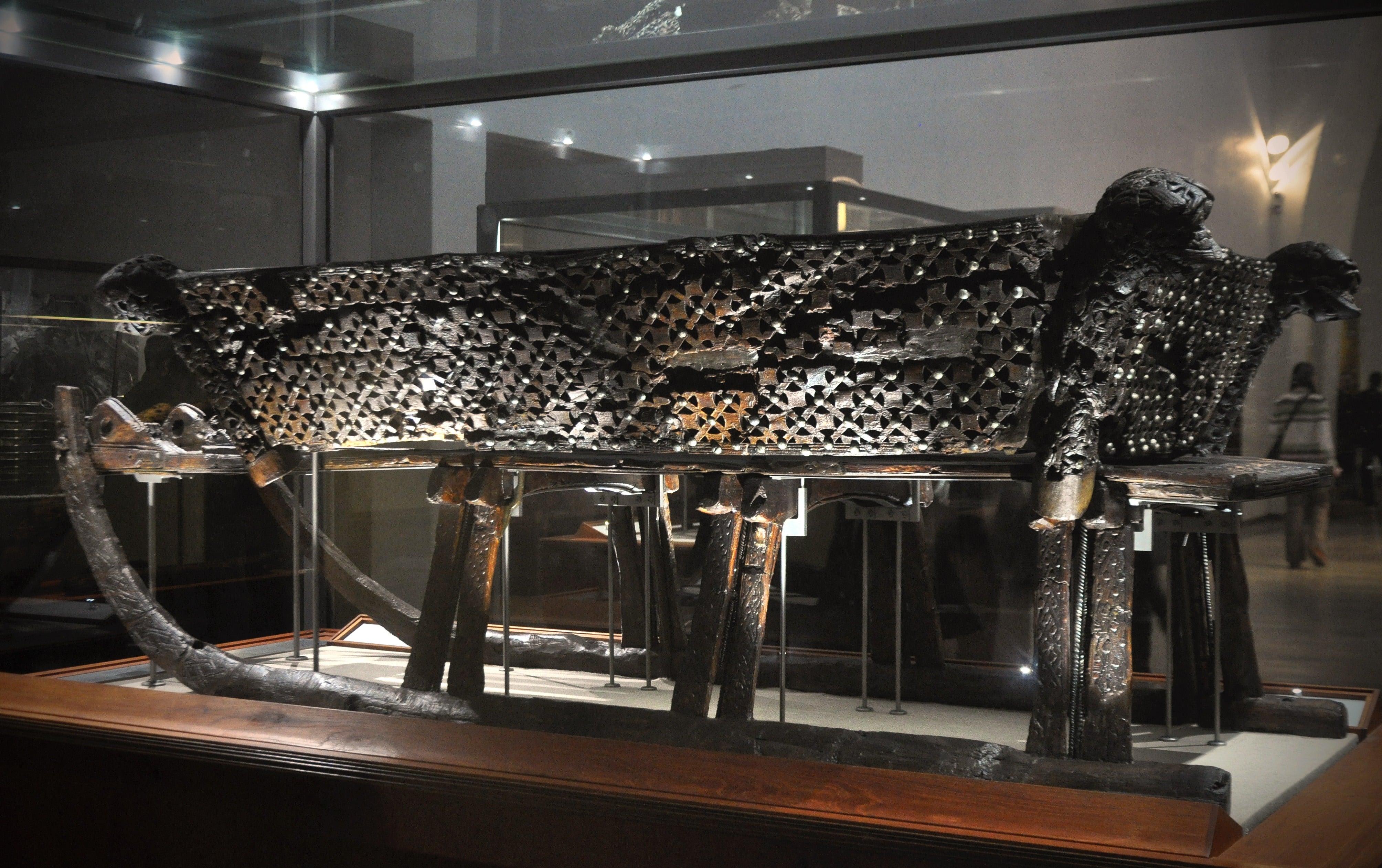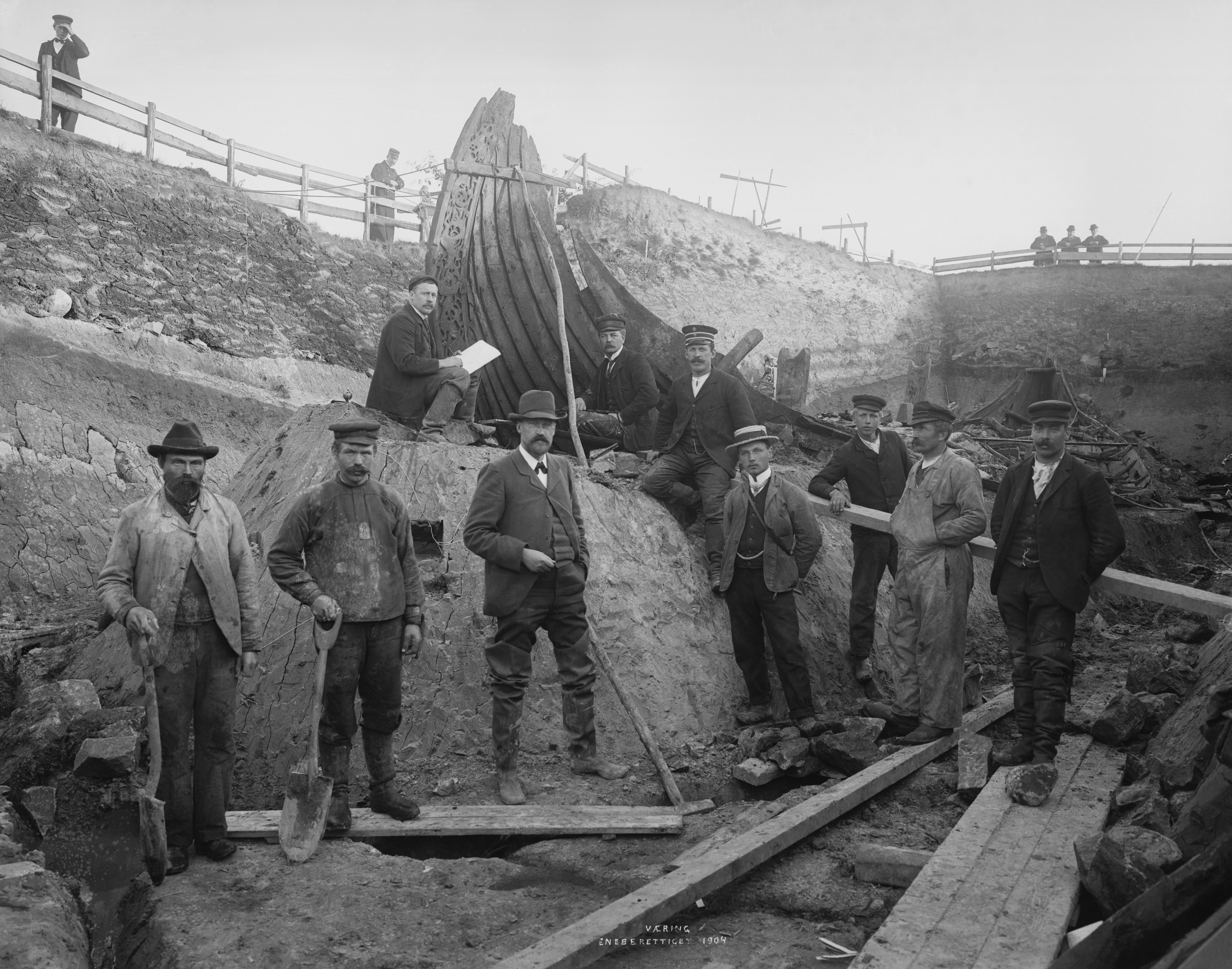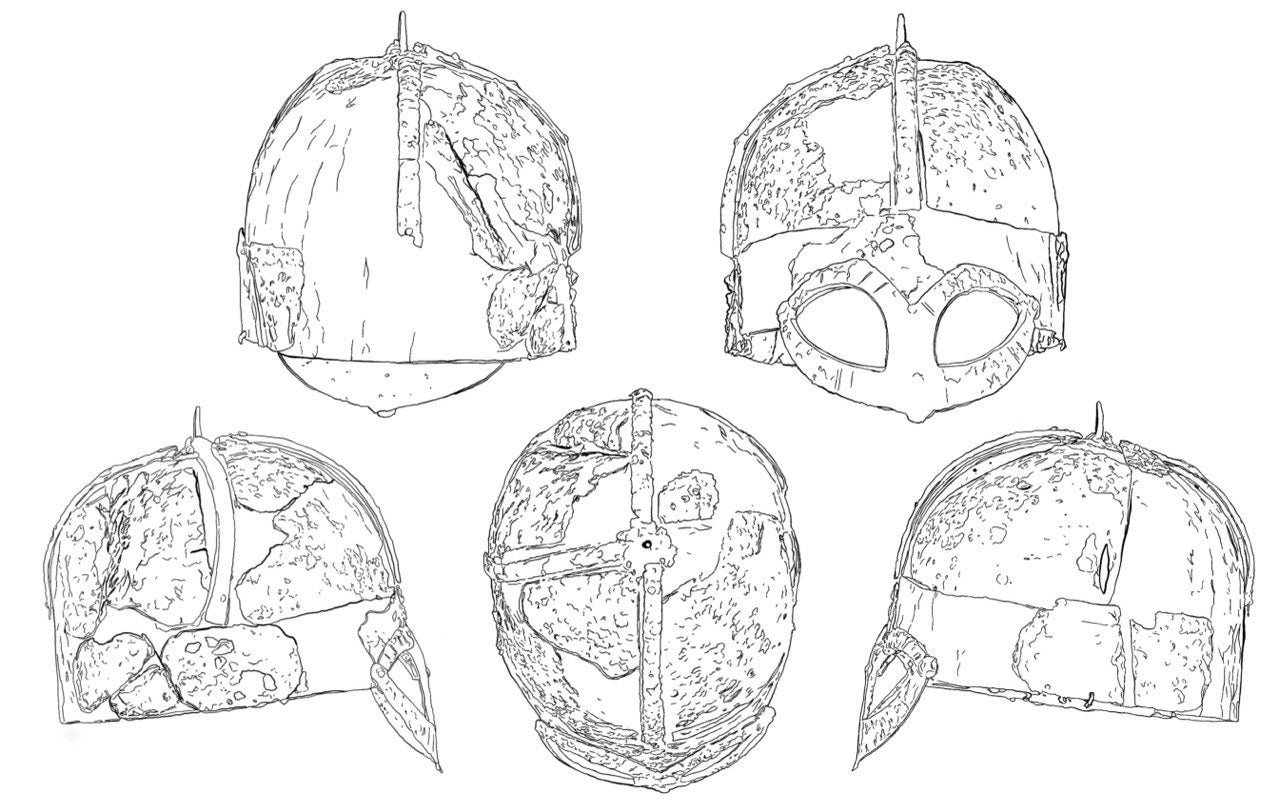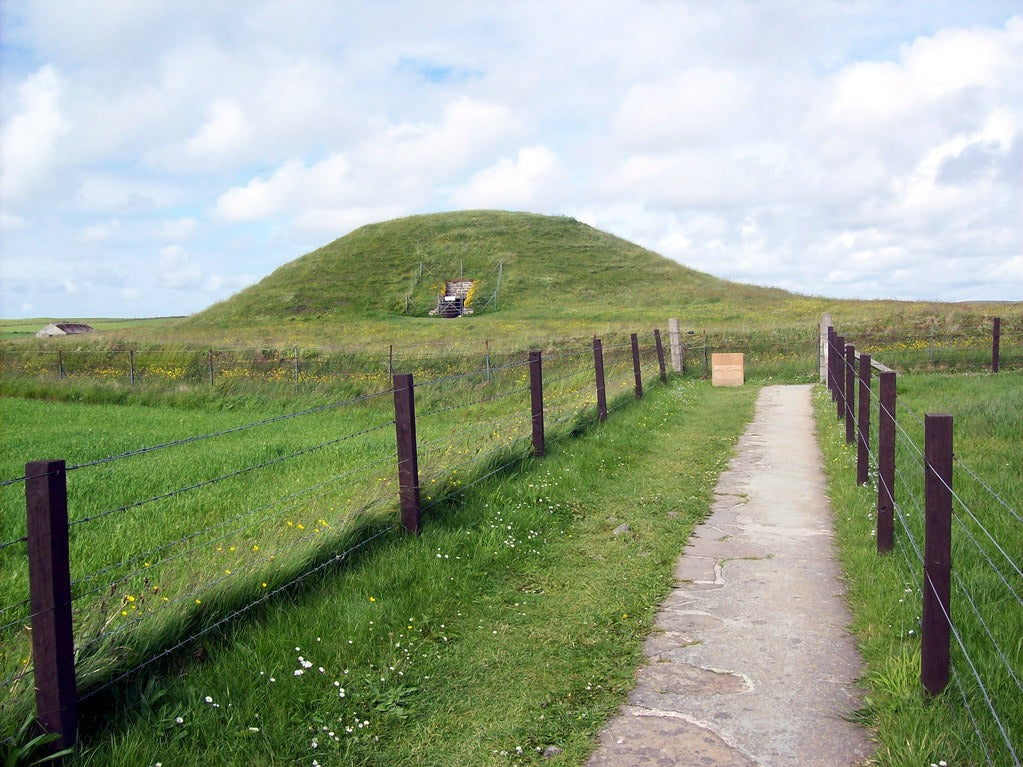
Winter's Chariots: The Oseberg Sleighs and Viking Craftsmanship
In the frozen landscapes of Viking-age Norway, where fjords cut deep into the earth and northern lights dance across winter skies, a different kind of artistry once glided across the snow. The Oseberg sleighs, silent sentinels of a bygone era, offer us a glimpse into a world where functionality and beauty intertwined in ways we're only beginning to understand.
Discovery of the Oseberg Ship Burial

Unearthing a Norse Treasure Trove
The story of the Oseberg sleighs begins not with their creation, but with their rediscovery. In 1903, on a farm near Tønsberg in Vestfold, Norway, the earth reluctantly gave up one of its most closely guarded secrets. As shovels bit into the soil of a large burial mound, they revealed the outlines of a ship - not just any ship, but one of the most spectacular Viking burial ships ever found.
The Significance of the Find
As archaeologists carefully peeled back layers of earth and time, they uncovered a veritable treasure trove of Viking artifacts. Among the riches - the intricately carved ship itself, textiles, household items, and the remains of two women - were four wooden sleighs, each a masterpiece of Norse craftsmanship. These sleighs, silent for over a millennium, were about to revolutionize our understanding of Viking technology, art, and daily life.
The Oseberg Sleighs: An Overview

Description and Design
The Oseberg sleighs, four in total, vary in size and design, but all share a grace and elegance that belies their age. Crafted from oak, these vehicles feature curved runners that would have glided smoothly over snow and ice. The largest of the sleighs stretches nearly 5 meters in length, its graceful lines suggestive of both speed and stability.
Craftsmanship and Artistry
But it's not just their form that captures the eye - it's the exquisite decoration that adorns them. Every surface of these sleighs tells a story, carved with an intricacy that speaks volumes about Viking artistic sensibilities.
Carving Techniques
The sleighs showcase a variety of carving techniques, from deep relief work to more subtle, incised designs. The skill of the carvers is evident in every curve and line, demonstrating a mastery of woodworking that rivals any in the ancient world.
Symbolic Motifs
The decorative elements are not merely aesthetic. Intertwined animal forms, human figures, and abstract patterns dance across the wood, each likely laden with symbolic meaning. Dragons, horses, and sinuous, snake-like creatures twist and turn, creating a visual narrative that we're still working to fully decipher.
Purpose and Function of the Sleighs

Practical Uses in Viking Society
While it's tempting to view these sleighs purely as works of art, they were undoubtedly functional vehicles as well. In a land where winter held sway for much of the year, sleighs would have been essential for transportation across snow-covered terrain. These particular sleighs, with their fine craftsmanship, likely belonged to individuals of high status, perhaps used for both practical travel and ceremonial processions.
Ceremonial and Ritual Significance
The presence of the sleighs in a burial context suggests they held deeper meaning beyond mere transportation. Were they intended to carry the deceased into the afterlife? Did they play a role in religious ceremonies? The answers remain elusive, but the questions themselves offer fascinating insights into Viking beliefs and practices.
The Sleighs in Context

The Oseberg Wagon / Photo: Tuey, CC BY 2.0
Comparison to Other Viking Age Vehicles
The Oseberg sleighs are not alone in the pantheon of Viking vehicles. Wagons, carts, and of course, ships, all played crucial roles in Norse society. Yet the sleighs stand out for their unique combination of practicality and artistry. They offer a winter counterpart to the famous longships, demonstrating the Vikings' mastery over both land and sea.
Insights into Viking Technology
Studying the construction of these sleighs provides valuable insights into Viking technology. The use of iron fittings, the sophisticated woodworking techniques, and the overall design all speak to a level of technological advancement that challenges outdated notions of the Vikings as mere primitive warriors.
Preservation and Restoration Challenges in Conservation
Preserving wooden artifacts over a thousand years old is an immense challenge, and the Oseberg sleighs present a particularly complex case. Initially treated with alum salts during their excavation in 1904, these preservation methods have ironically contributed to their current fragile state.
Recent Deterioration Concerns
Despite earlier conservation efforts, the Oseberg sleighs are now at significant risk of deterioration (as of mid-2024). The wood has continued to degrade, and the iron rods holding the pieces together have corroded. Currently, the sleighs are primarily held together by a brittle crust of alum and an external layer of lacquer and glue, leaving them in a precarious condition.
Government Initiative and Research Project
Recognizing the urgency of the situation, the Norwegian government has allocated nine million Norwegian Kroner to fund a comprehensive research project. Led by the Museum of Cultural History at the University of Oslo, the "Saving Oseberg" project aims to develop new conservation methods specifically for these artifacts.
Modern Techniques and Future Preservation
The six-year project, with a total projected cost of 53 million Norwegian Kroner, involves collaboration with international experts in conservation science, wood chemistry, and Viking Age archaeology. Under the leadership of conservator Susan Braovac, the team is working to devise sustainable and effective conservation techniques to preserve both the structural integrity and aesthetic value of the sleighs.
The project involves detailed assessment, development of new conservation methods, and careful implementation. This initiative not only aims to save these priceless artifacts but also to advance the field of archaeological conservation, potentially benefiting the preservation of similar historical wooden artifacts worldwide.
The Oseberg Sleighs in Norse Culture

Connections to Norse Mythology
The intricate carvings on the sleighs offer tantalizing connections to Norse mythology. Are those writhing forms depictions of Jörmungandr, the world serpent? Do the horse motifs reference Sleipnir, Odin's eight-legged steed? Each curve and line potentially holds a key to understanding the rich tapestry of Norse beliefs.
Social Status and Wealth Display
The presence of such finely crafted items in a burial mound speaks volumes about the social status of the deceased. These weren't just functional items, but statements of wealth and power. In a society where gift-giving and display played crucial roles, such ornate sleighs would have been potent symbols of one's place in the social hierarchy.
Legacy and Influence

The Oseberg Viking Ship
Impact on Our Understanding of Viking Culture
The discovery of the Oseberg sleighs has profoundly impacted our understanding of Viking culture. They challenge the stereotype of Vikings as merely brutal warriors, revealing instead a society capable of producing objects of great beauty and sophistication. These sleighs have become a window into the daily lives, beliefs, and artistic sensibilities of our Norse ancestors.
Inspiration for Modern Design and Art
The influence of the Oseberg sleighs extends beyond the realm of historical study. Their elegant lines and intricate designs have inspired modern artists and designers, influencing everything from furniture to tattoo art. In this way, these ancient vehicles continue to glide through history, leaving their mark on our contemporary world.
Conclusion: Sliding into History
As we stand before the Oseberg sleighs in their museum home, we're not just looking at relics of a bygone age. We're peering through a window into a world both familiar and alien - a world where art and function blended seamlessly, where the mundane and the divine danced in intricate patterns across the surface of everyday objects. These sleighs, with their graceful lines and mysterious carvings, continue to captivate us, inviting us to look deeper, to ask questions, to imagine the hands that carved them and the landscape they once traversed.
In the end, the Oseberg sleighs are more than just beautiful artifacts. They are messengers from the past, carrying with them stories of Viking life, art, technology, and beliefs. As we continue to study and admire them, we're not just learning about history - we're engaging in a dialogue with our ancestors, gliding across the snows of time to touch the very heart of Viking culture.
FAQs
- How old are the Oseberg sleighs?
The Oseberg burial, including the sleighs, dates back to around 834 CE, making the sleighs nearly 1200 years old.
- Were the sleighs actually used or were they made specifically for burial?
While it's difficult to say with certainty, the wear patterns on some of the sleighs suggest they were used before being placed in the burial.
- How many sleighs were found in the Oseberg burial?
Four sleighs were discovered in the Oseberg ship burial, each with unique designs and dimensions.
- Can visitors see the original Oseberg sleighs today?
Yes, the Oseberg sleighs are on display at the Viking Ship Museum in Oslo, Norway.
- Were similar sleighs used throughout the Viking world?
While the Oseberg sleighs are unique in their level of preservation and decoration, sleighs were likely used throughout Scandinavia during the Viking Age.
References
Brøgger, A.W., & Shetelig, H. (1917). Osebergfundet. Kristiania: Universitetets Oldsaksamling.
Christensen, A.E., Ingstad, A.S., & Myhre, B. (1992). Osebergdronningens grav. Oslo: Schibsted.
Gansum, T. (2004). "Role the Dice: The Oseberg Ritual Complex." Current Swedish Archaeology, 12, 163-177.
Bill, J., & Daly, A. (2012). "The plundering of the ship graves from Oseberg and Gokstad: an example of power politics?" Antiquity, 86(333), 808-824.
Pedersen, U. (2016). "Into the Melting Pot: Non-Ferrous Metalworkers in Viking-Period Kaupang." In Proceedings of the 22nd Viking Congress.
"Wagon from Oseberg collection, Vikingskipshuset (viking ship museum), Oslo" by tuey is licensed under CC BY 2.0.
"Osebergssläde, Norge - 8182948815 Oseberg Viking sleigh. Viking Ship Museum, Oslo, Norway (Vikingskipshuset på Bygdøy) 2011" by Bochum1805 is licensed under CC BY-SA 2.0.
"Detail of a sleigh from the Oseberg ship burial, around 800, Norway. Viking Ship Museum, Oslo, Norway (Vikingskipshuset på Bygdøy) 2011" by Bochum1805 is licensed under CC BY-SA 2.0.
"The Oseberg ship. Viking Ship Museum, Oslo, Norway (Vikingskipshuset på Bygdøy) 2011" by Bochum1805 is licensed under CC BY-SA 2.0.
"Grave goods from the Oseberg ship burial, around 800, Norway. Oseberg Viking sleigh. Viking Ship Museum, Oslo (Vikingskipshuset på Bygdøy) 2011" by Bochum1805 is licensed under CC BY-SA 2.0.
"Oseberg sleigh. Viking Ship Museum, Oslo, Norway (Vikingskipshuset på Bygdøy) 2011" by Bochum1805 is licensed under CC BY-SA 2.0.
"CfO0176 museum no. C55000 1 Osebergskipet utgravning, professor Gustafson og mannskapet (Oseberg ship 1904. Photo Olaf Væring, Kulturhistorisk museum UiO Oslo, Norway. License CC BY-SA 4.0)" by Olaf Væring (1837-1906) / Kulturhistorisk museum, UiO (Museum of Cultural History, part of the University of Oslo, Norway) is licensed under CC BY-SA 4.0.








